Sketchbook inspiration can come from just about anywhere! Artists love drawing from fashion trends, wild patterns, or that mysterious bird outside your window. Try self-portraits, doodle your friends, or capture busy city scenes. Mix up different art materials—think charcoal and magazines, or watercolors and gouache—for cool effects. Everyday objects, funny memories, and even favorite photos spark fresh ideas. Art challenges and nature walks are classics too. Want more ways to make your sketchbook pages pop? Keep going!
Key Takeaways
- Experiment with mixed media by combining watercolors, gouache, collage, or found objects for unexpected effects.
- Draw inspiration from fashion magazines, urban scenes, or everyday objects to keep sketchbook pages lively and relatable.
- Practice anatomy and figure studies to improve your artistic skills and add dynamic movement to sketches.
- Document personal memories, friendships, or milestones through illustrated stories, self-portraits, and incorporating mementos.
- Participate in art challenges like Inktober to explore new prompts, styles, and techniques regularly.
Explore the World of Fashion
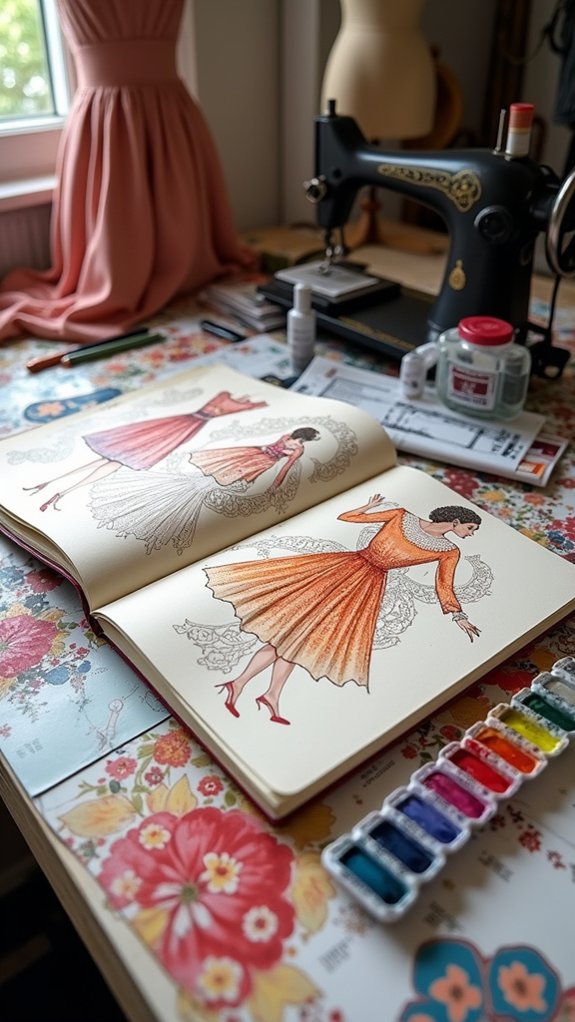
If someone wants to jazz up their sketchbook, diving into the world of fashion is like opening a magical wardrobe—full of wild colors, bold styles, and tons of possibilities.
Exploring sketchbook ideas inspired by fashion means raiding old magazines for cool images to cut and paste, turning pages into mixed media masterpieces. Using fun art materials like gouache paints gives everything a pop—almost like a neon sign shouting, “Look at me!”
Fashion isn’t just about clothes; it’s about clever accessories, crazy patterns, and wild textures. Observing brands like Gucci, plus legendary fashion illustrators, sparks more ideas than a firework show.
It’s about mixing, matching, and mastering the madness. Fashion sketches aren’t just outfits—they’re imagination, messiness, and artistic dreams coming to life.
Study Human Anatomy
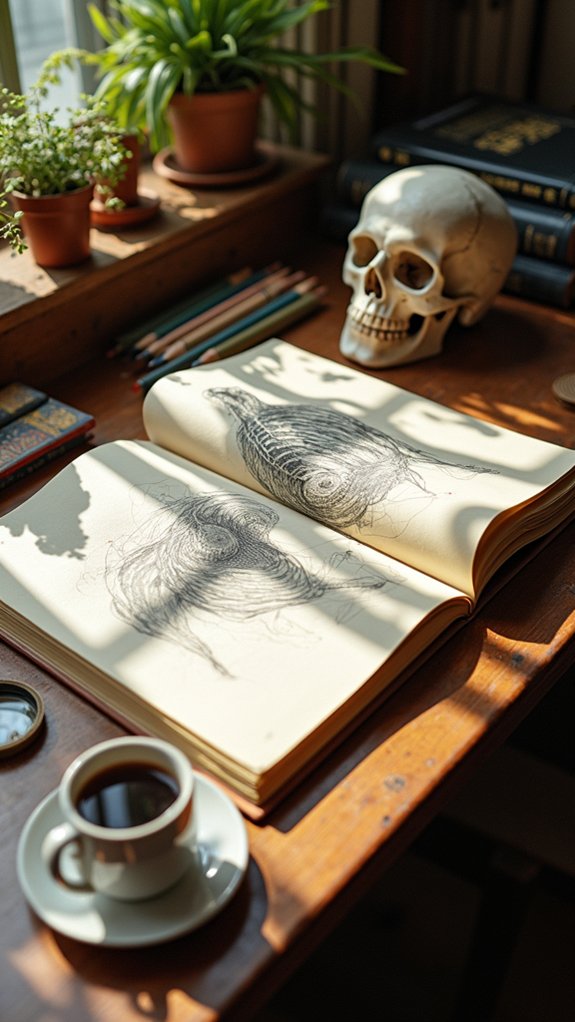
Studying human anatomy can turn an ordinary sketchbook into a mini science lab—minus the scary experiments!
Focusing on mastering facial proportions helps artists capture every smirk, frown, and goofy grin, while dynamic figure drawing brings these characters to life as if they might jump right off the page.
Even just getting the elbows and knees in the right spot feels like revealing a secret power, and who doesn’t want to feel like an art wizard?
Mastering Facial Proportions
Even the coolest superhero sketch can look a little wonky if the facial features aren’t in the right spots. Mess up the eye line and, suddenly, Batman’s looking more confused than brooding.
In every sketchbook or art journal, it pays to know the simple rules: eyes halfway down the head, about an eye’s width between them, and the face is roughly five eyes wide. The nose ends in line with the bottom of the earlobe. The mouth? About a third of the way from the nose to the chin.
If you want to draw something that really looks human, practice drawing faces at all sorts of angles. Peek at anatomy books for extra help. The more you practice, the less your portraits will unintentionally resemble aliens.
Dynamic Figure Drawing
Almost every artist has faced the wild challenge of making a character leap, twist, or strike a heroic pose—without the arms turning into spaghetti noodles or the legs looking like pool cues.
Dynamic figure drawing is all about bringing life and movement into your art, making characters pop right off the page. To master dynamic poses, artists dive deep into anatomy studies—learning muscles, bones, and proportions, which is way less scary than it sounds!
Filling your sketchbook with quick gesture drawings, stick-figure action scenes, and colored pencil notes can breathe fresh energy into your pages. Life drawing sessions seriously level up observation skills, helping artists capture movement like pros.
Checking out legends like Rey Bustos for inspiration isn’t cheating; it’s just smart sketchbook strategy!
Create Self-Portraits
While it might feel a little awkward to stare at your own face for ages, creating self-portraits is actually a powerful way to tell your story and figure out who you are—all with nothing but some art supplies and a sketchbook.
Think of your sketchbook as a visual diary, a place to play around with different styles and moods. Famous artists like Vincent van Gogh practically turned their art books into emotion-filled timelines with self-portraits, and you can, too.
Try out watercolors when you feel dreamy, or grab some bold ink on the days you’re feeling dramatic. Don’t worry about making it look picture-perfect. Add stuff that matters to you—hobbies, memories, or even a favorite hoodie.
- Wild, colorful backgrounds
- Serious or silly facial expressions
- Personal objects (like headphones or sketches)
- Abstract designs for mood
- Experiments with art supplies
Sketch Your Favorite Sculptures
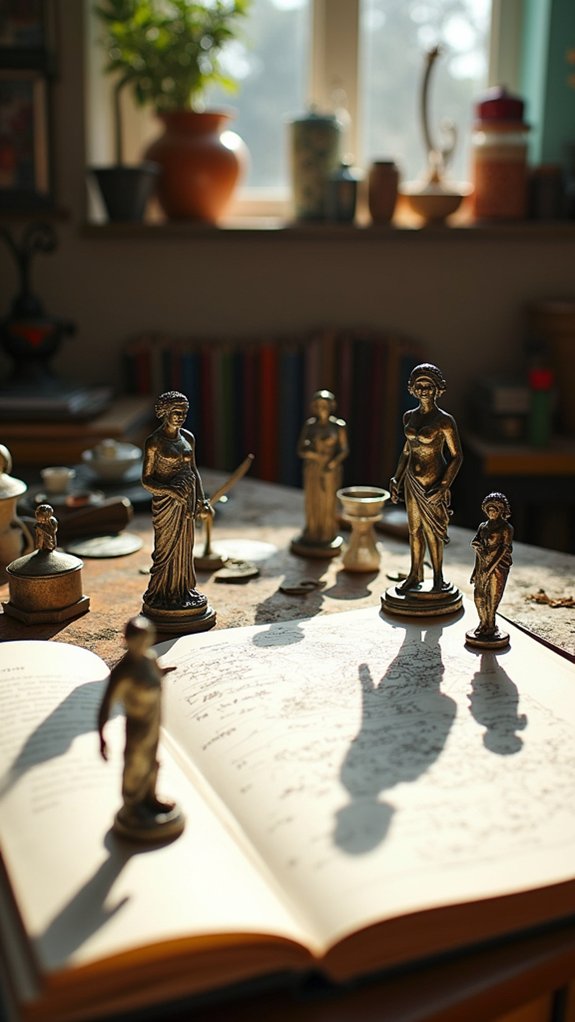
Sketching famous sculptures is like a workout for your artistic muscles—suddenly, all those curves, muscles, and shadows become a serious challenge.
Studying masterpieces from the Renaissance, such as Michelangelo’s “David,” helps you see how artists got anatomy and movement just right, and you’ll need some high-quality shading skills to show off all that three-dimensional depth.
Mastering Shading Techniques
Even serious artists know that mastering shading is kind of like learning a magic trick—suddenly, flat drawings pop to life with curves and shadows that jump off the page.
Shading techniques can completely shake up your sketchbook pages, especially when you’re sketching your favorite sculptures. To really pull off those rich, dramatic shadows and smooth highlights, notice how the light source plays with the form.
Try using all kinds of pencils and even some oil pastels for bold, moody effects. Don’t be afraid to smudge and blend for softer changes—just don’t get graphite everywhere!
Here are some tips to help your shading skills level up:
- Study sculptures from different angles
- Use a range of pencils for texture
- Blend with tortillons or fingers
- Observe highlights and shadows
- Practice regularly with various sculptures
Exploring Renaissance Anatomy
Lights and shadows can turn the ordinary into something jaw-dropping, but the real magic shows up when artists study the actual bodies behind all those curves and muscles. During the Renaissance, artists like Michelangelo flexed their skills by carving sculptures so realistic it’s almost rude not to stare. For anyone with a sketchbook, diving into these masterpieces is way better than just copying cartoons. It’s art, but also a secret anatomy lesson—those proportions, crazy muscle shapes, and flowing poses weren’t just lucky guesses. Check out the possibilities in this table:
| Renaissance Trick | What Artists Learn |
|---|---|
| Contrapposto Stance | Drawing lifelike movement |
| Detailed Muscles | Human form, inside and out |
| Dramatic Lighting | Superior shading skills |
With each new drawing, the possibilities are endless!
Capturing Three-Dimensional Forms
Although staring at a sculpture might sound like something only art snobs do, anyone with a pencil can discover just how awesome it is to capture a three-dimensional masterpiece on paper.
Sculptures are a great place to start if you want to boost your skills in your new sketchbook, especially if you have some reference images or a little statue lying around at home.
Sketching these cool, ancient works—especially from the Renaissance period—can help you get the hang of anatomy and shading like a pro.
Try out different drawing tricks, from contour lines to hatching, or even switch it up with charcoal for major drama.
- Study classical statues at a museum.
- Use dramatic lighting to highlight textures.
- Draw from unusual angles.
- Focus on hands, faces, or details.
- Layer shading for realistic depth.
Participate in Art Challenges

Jump into the world of art challenges, and suddenly creating art feels way more exciting—even a little daring. Art challenges like Inktober or Mermay give new life to your sketchbook with daily prompts, daring artists to try styles, subjects, and mediums they might have skipped before.
For high school students (or anyone, honestly), it’s a cool way to keep the creative engine running. You get to make art, post it online, and see what others did with the same prompt. There’s something thrilling about seeing your idea next to someone else’s!
Sometimes the challenge is just sticking with it, but documenting the journey—tiny sketches, scribbled notes—shows how much you grow. Creative blocks? They don’t stand a chance.
Recreate Artworks by Masters
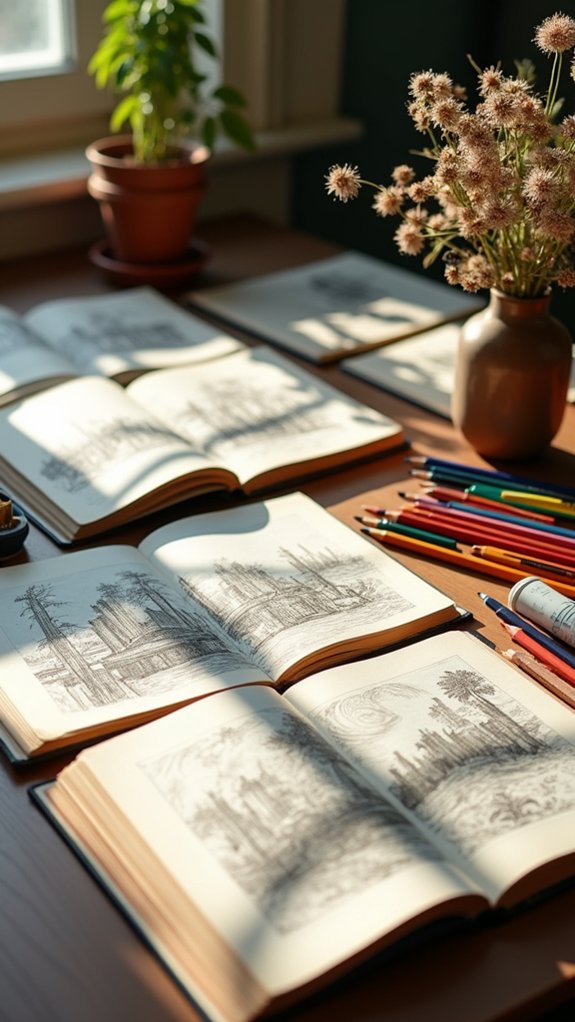
Some of the best art ideas actually come from looking back—way back—to the classics. When artists recreate artworks by the masters, they’re not just copying for fun or homework—they’re on a time-traveling art adventure.
Exploring masterful brushwork from artists like Van Gogh or Rembrandt helps artists see how bold, crazy strokes can totally change a piece. With color palette analysis, they can discover why a certain combination makes people feel happy, gloomy, or even jumpy!
By holding a tiny printout of a famous painting next to their sketch, young artists can zoom in on the emotional impact the original delivers. It’s like learning the secrets behind the magic. Every recreated piece holds new discoveries, and sometimes a doodle turns into a masterpiece!
- Study brushstroke techniques of Van Gogh
- Analyze Rembrandt’s color choices
- Match mini-prints with your sketches for comparison
- Jot down notes about what feels powerful or moving
- Add your own creative twist to a classic piece
Doodle Everyday Life
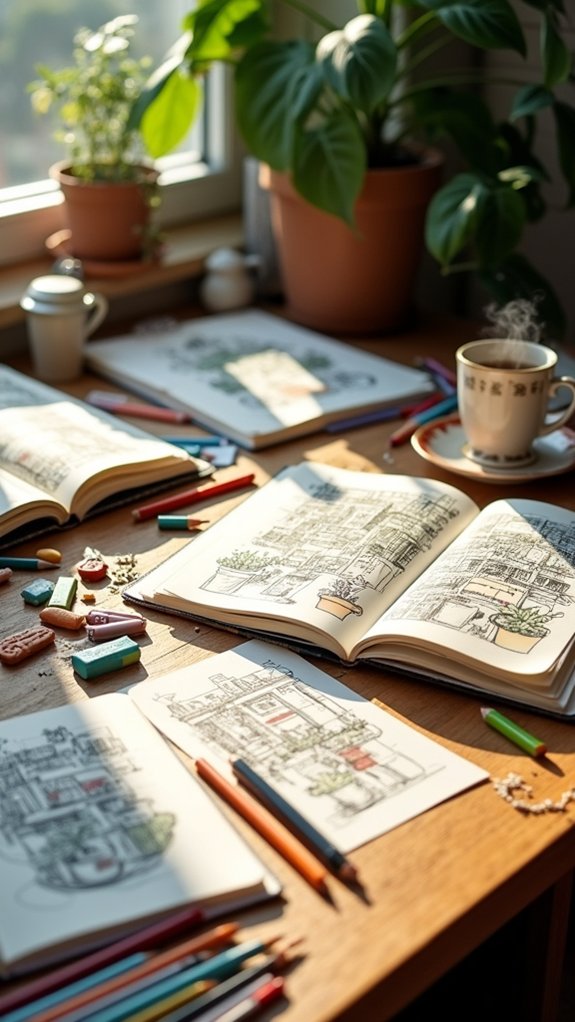
Sometimes, the coolest art comes from sketching the most ordinary stuff—like a messy desk, a pile of laundry, or that weird-looking sandwich packed for lunch.
By turning everyday objects into quirky doodles, artists get to find hidden beauty in routines and maybe even make a coffee mug look like it’s telling jokes.
It’s a way to see magic in the boring parts of life, all with just a pencil and a bit of imagination.
Transform Mundane Into Art
Grab a sketchbook and look around—there’s a whole world of art hiding in plain sight. Transforming the everyday into art doesn’t require a fancy subject. Just doodle what’s near you!
Artists master doodle techniques to capture little things—like coffee mugs or tangled earbuds—and turn them into something totally joyful. This habit brings sketching joy and erases the pressure to be perfect. Every squiggle and line comes from everyday inspiration, helping you see magic in the mundane.
Throw in textures, fun patterns, or color pops, and suddenly a regular scene feels special!
- Morning toast with melting butter
- Sneakers tossed by the door
- A cozy patch of blanket
- Messy stacks of books or notebooks
- Leafy potted plants on the windowsill
Whimsical Daily Object Sketches
Even the most ordinary things sitting on a desk or in a backpack have secret stories to tell—if anyone’s willing to doodle them.
With whimsical sketches, a bored eraser becomes an explorer, and a mug turns superhero. Artists, like Mattias Adolfsson, twist everyday doodles into mini adventures, using colored pencils, ink, or even watercolors for extra pop.
These playful narratives make a simple stapler the star of a comic strip, or give a set of paperclips wild geometric patterns that loop and dance across a page. Adding little jokes or thought bubbles ramps up the fun, making each doodle personal.
The next time a pencil looks plain, imagine its secret life—and start sketching its hidden adventures, one silly story at a time.
Find Beauty in Routine
While most people rush through daily routines without a second glance, sketchbook artists see hidden gems everywhere—a coffee cup balanced on a stack of books or sneakers kicked off under a kitchen table. They know that everyday inspiration hides in plain sight, waiting to be noticed.
Routine sketches bring out the mundane beauty of the world, and across each page, doodles tell stories about life’s simplest moments. There’s no fancy setup needed; just grab a pen and capture snippets from home, school, or a favorite hangout.
Even rushed breakfasts or messy desks can become art! If you’re stuck for ideas, start with:
- A rainy window and a steaming mug
- A jumble of tangled earphones
- Breakfast toast with unique toppings
- Keys tossed after school
- A half-open backpack spilling books
Draw Comfortable Subjects
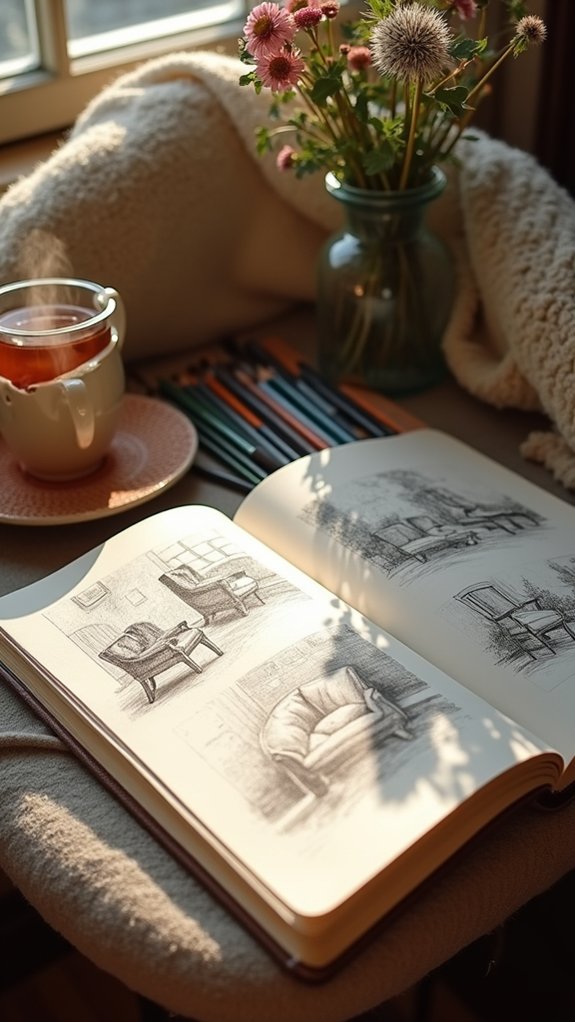
Sometimes, the best place to start in a sketchbook is right in your own comfort zone. Drawing familiar things like pet portraits, favorite objects, or the cozy corners of personal spaces can make picking up a pencil feel a lot less intimidating.
When you choose subjects you know and love, it’s like getting a pep talk from your own art. Mistakes seem smaller, and you get to try new techniques on things that matter to you. It’s also a sneaky way to build a strong visual theme—think of a whole page filled with just your favorite sneakers, or every dog you’ve ever known!
Sketching comfortable subjects helps artists develop confidence and a style all their own, forming a solid base for future challenges.
Experiment With New Mediums

After filling page after page with favorite things, there’s a point when the sketchbook starts whispering, “Let’s try something wilder.”
That’s when experimenting with new mediums can totally shake things up for an artist. Think about it—Acrylic experimentation can produce bold, layered colors you never knew you loved.
Watercolor techniques introduce swooshes and splashes, impossible to predict but always lively.
Mixed media exploration? That’s where chaos gets creative, mashing up everything from charcoal to old ticket stubs into artwork nobody’s seen before!
Don’t forget about digital tools, either—they’re like magic wands for your imagination.
Trying new stuff can make every page feel like an adventure.
- Swiping bold acrylics across rough paper
- Layering in dreamy watercolor washes
- Scribbling with charcoal over ink
- Mixing collage bits with everyday sketches
- Tapping colors onto a tablet screen
Document Memories and Milestones
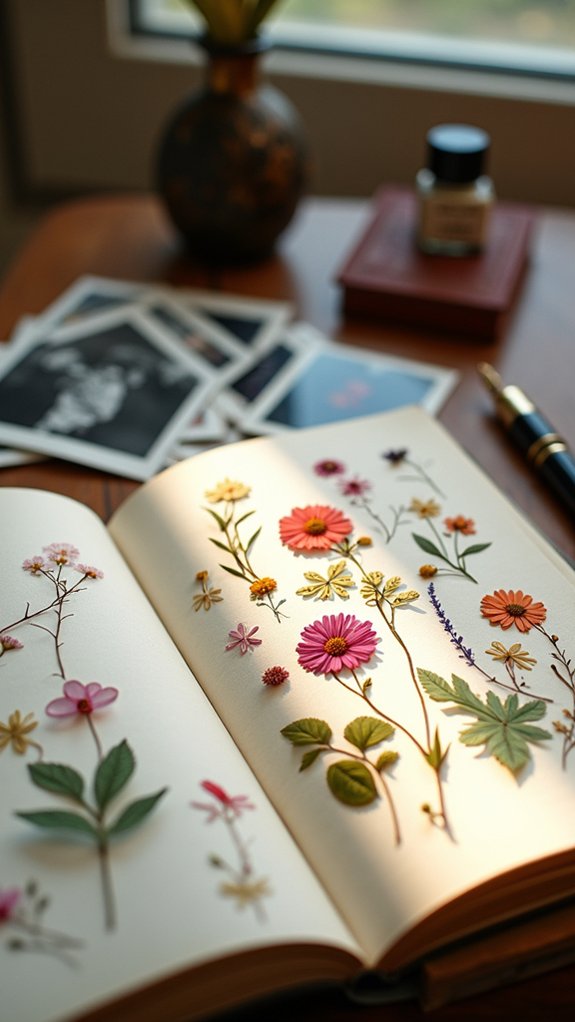
Nothing brings a sketchbook to life quite like pages filled with moments that actually happened—think birthday party snapshots, old concert tickets, or even that embarrassing middle school yearbook photo.
Capturing special events as art turns a sketchbook into a visual journey, where every drawing or scrap glued down marks another step in someone’s story.
It’s like making your own comic book of real memories, complete with all the wild adventures and awkward victories along the way.
Capturing Special Life Events
Why do some memories seem to stick with a person forever, while others slip away like water in your hands?
Sketching special life events isn’t just about cute doodles or pretty pages—it’s memory documentation that truly counts. When people draw moments like graduations, that wild summer road trip, or even a silly birthday, they create visual narratives that lock in emotional connections.
Mixed media makes it come alive, turning simple sketches into mini time machines. Personal notes and mementos add even more magic, helping feelings and details last.
- A watercolor scene of a wedding dance, all swirly blues and pinks
- Concert ticket stubs glued beside doodles of dancing friends
- Inked journal entry about finally learning to ride a bike
- Passport stamps layered under sketched cityscapes
- Handwritten quotes from loved ones in swirling script
Visual Chronology Through Art
When a sketchbook turns into a kind of visual timeline, it’s like building your own time-travel device—no DeLorean required!
Artists can use memory mapping to chart their life journey, drawing key memories and artistic milestones on each page. Photographs, movie tickets, or even random doodads taped in become springboards for epic storytelling.
Adding mixed media, like decoupage or paint splatters, cranks up the emotional reflections, making memories pop with texture and heart. Don’t forget to jot down dates or notes beside the art; these details give extra context and help track growth.
Basically, your visual chronology grows with you. Plus, flipping back through your pages is like binge-watching your own highlight reel—one filled with gratitude, nostalgia, and all your best bits.
Practice On-Location Sketching
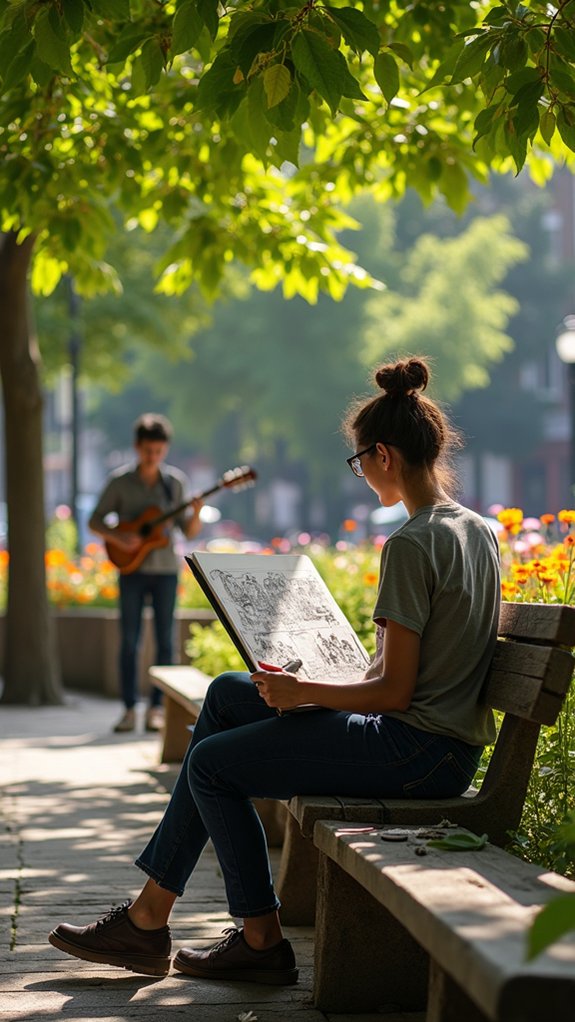
Ever wondered what it feels like to turn a busy street or a sunny park into a living sketchbook? That’s exactly what happens when you try on-location sketching.
Using urban sketching techniques and outdoor drawing tips, artists get out of the studio to soak up the real world. You don’t need fancy tools—just a compact sketchbook and a pen in your pocket, ready for some spontaneous art sessions whenever inspiration strikes.
Being out there, artists notice so many details they’d usually miss: moving crowds, quirky birds, even spilled coffee shapes! Local events are perfect for truly lively sketches, full of different people and moments.
- Sketch musicians at a festival
- Draw coffee shop conversations
- Capture park joggers mid-stride
- Record market hustle and bustle
- Illustrate colorful city murals
Illustrate Meaningful Friendships
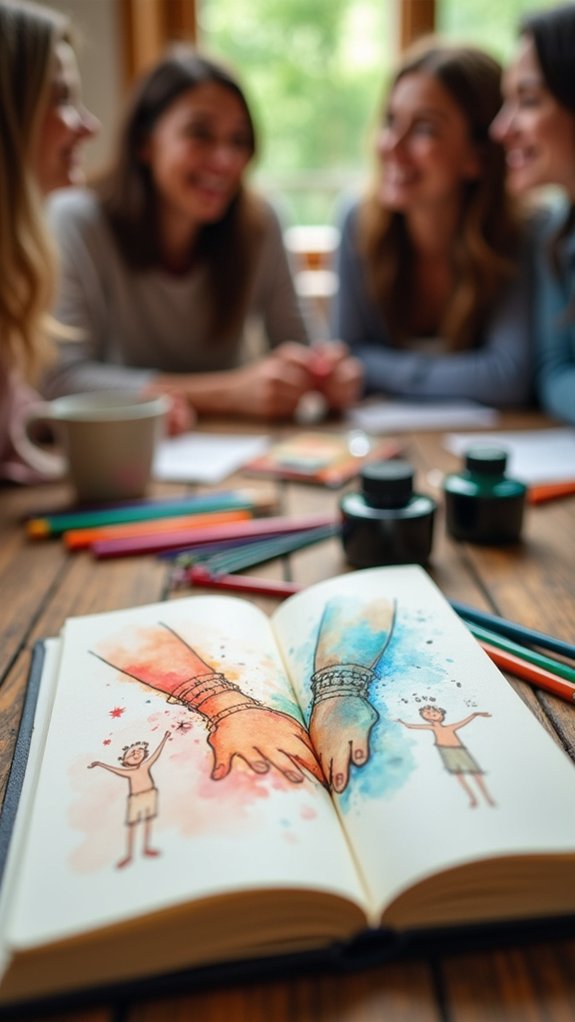
Illustrating meaningful friendships in a sketchbook is like catching lightning in a bottle—full of color, energy, and those inside jokes only you and your friends understand.
By using personal touches like photos or souvenirs, and playing around with funky styles or vibrant colors, anyone can tell the wild, funny, or even mushy stories that friendships create.
With each sketch, the page turns into a time machine stuffed with shared memories and personalized details that make every friendship shine.
Capturing Shared Memories
Nostalgia can sneak up out of nowhere, especially when flipping through old sketchbooks packed with memories of friends and wild adventures.
Capturing shared memories becomes something magical with just a few clever choices. Try mixing Memory Collage Techniques like gluing in old photos or ticket stubs right beside a goofy doodle of your best friend.
For some extra sparkle, Friendship Sketch Inspirations might come from drawing places you both love, or that time you accidentally wore matching shirts. Adding Nostalgic Illustration Ideas—think favorite movie quotes or inside jokes—brings each page to life.
- Draw hangout spots that mean everything to your crew
- Attach concert tickets, notes, or postcards using decoupage
- Doodle inside jokes or memorable quotes
- Try watercolors or gouache for bold, colorful pages
- Turn your adventures into a quirky visual journal
Visual Storytelling Techniques
Sometimes, a sketchbook page can tell a story bigger than any selfie or social post ever could. Using clever visual narrative techniques, an artist can capture the heartbeat of friendship with bursts of color, scribbled notes, or even a crumpled movie ticket glued right next to a doodle of shared laughter.
Artistic layering methods like decoupage turn ordinary pages into treasure chests, filled with snippets of inside jokes and memories. Mixing photos, handwritten thoughts, and even abstract brush strokes shows each friendship’s personality.
Color choices pump up the emotional resonance—warm oranges for giggly afternoons, cool blues for late-night talks. Adding favorite quotes or jokes beside sketches can make every page shine with meaning—like a shoutout to the people who make life awesome.
Personalizing Sketchbook Pages
Sharing stories in a sketchbook is like putting a spotlight on the magic that happens between friends, and there’s no better place to crank up that magic than on pages dedicated to meaningful memories.
Personalizing sketchbook pages with friendship memories brings emotional depth and makes your visual storytelling shine. It’s more than doodling faces—try mixing in photographs or old tickets, tossing in colors that scream “besties,” or maybe even gluing in that silly postcard from your summer road trip.
These details turn your art into a time machine, zapping you back to those moments. Here’s how to pack your sketchbook with friendship awesomeness:
- Layer photos, postcards, and handwritten notes
- Blend textures with decoupage
- Use friend-inspired color schemes
- Draw illustrated stories or comics
- Add friendship quotes in cool lettering
Reflect Through Visual Journaling
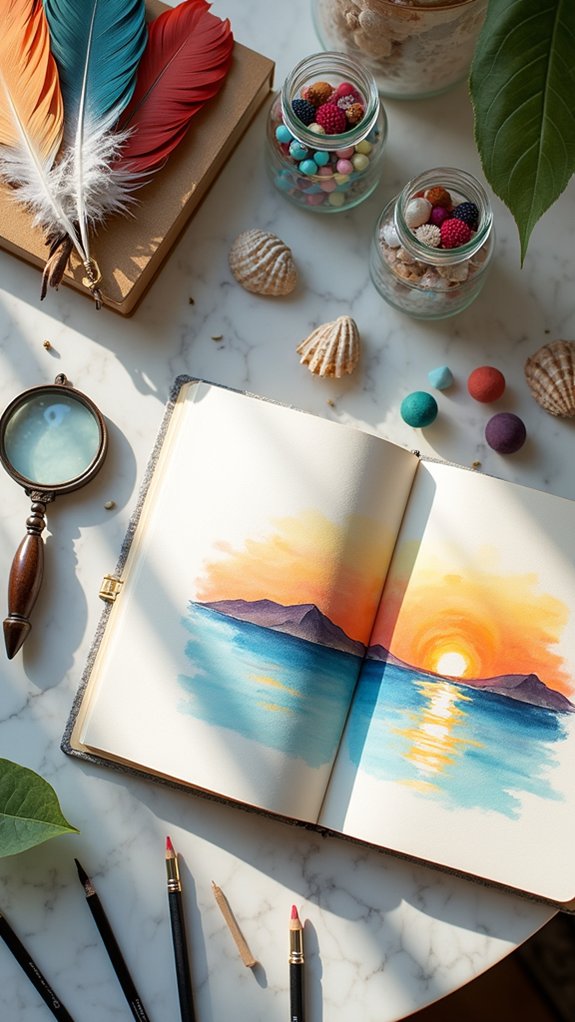
Ever wondered what happens when thoughts and doodles team up on the same page? Visual journaling turns a plain sketchbook into a playground for self discovery journeys and emotional expression.
Mixing watercolors, ink, or even random scraps of paper creates awesome chaos—like your brain, but cooler. Sometimes feelings and memories are hard to pin down with words, but a wild swirl of colors or a meaningful quote can nail them perfectly.
Creative exploration thrives when sketchbook pages don’t follow any rules. One day it’s pictures and poems, another day it’s silly cartoons.
Looking back, these pages are like a secret map showing how you grow, change, and discover your own unique style. Who knew reflecting could be this much fun?
Capture Nature’s Details

When the outside world starts showing off, there’s nothing better than diving into a sketchbook to catch every little detail nature throws your way.
Sketching becomes a kind of treasure hunt—every leaf, petal, or rock you spot holds a secret pattern or splash of color waiting to be captured. Observing nature textures up close lets artists play detective, uncovering hidden shapes while trying to master the way light bounces off a shiny leaf.
Whether it’s the wild explosion of seasonal colors in fall or a quiet tangle of roots in spring, botanical sketches always feel alive.
- Study zigzagging leaf veins and curling petals for cool patterns
- Use twigs or pressed flowers to add real-life texture
- Try sketching colorful, ever-changing scenes each season
- Snap photos of parks for future inspiration
- Visit a botanical garden for exotic plant discoveries
Observe and Sketch Architecture
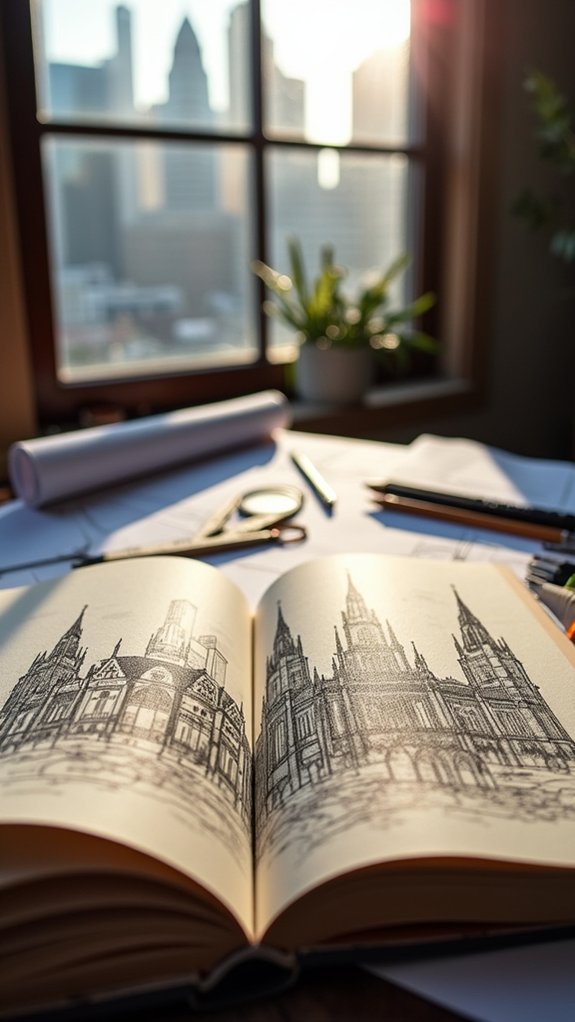
After hunting for wild colors and hidden shapes in nature, the adventure can keep going—with sketchbook in hand—onto city streets and between towering walls.
Cityscapes are full of quirky angles, interesting shadows, and all sorts of textures just begging to be drawn. By trying out urban sketching techniques, artists sharpen their skills and see how windows, doors, and rooftops connect, making spatial relationship studies much more fun than any boring textbook.
A gothic church might tower on one page, while a sleek modern building steals the next. Each outing is like an architectural styles exploration contest with yourself!
Throw in some passing people or grumpy pigeons for scale and laughs. After a few trips, sketchbooks become packed with fresh, personal city adventures.
Play With Patterns and Repetitive Designs
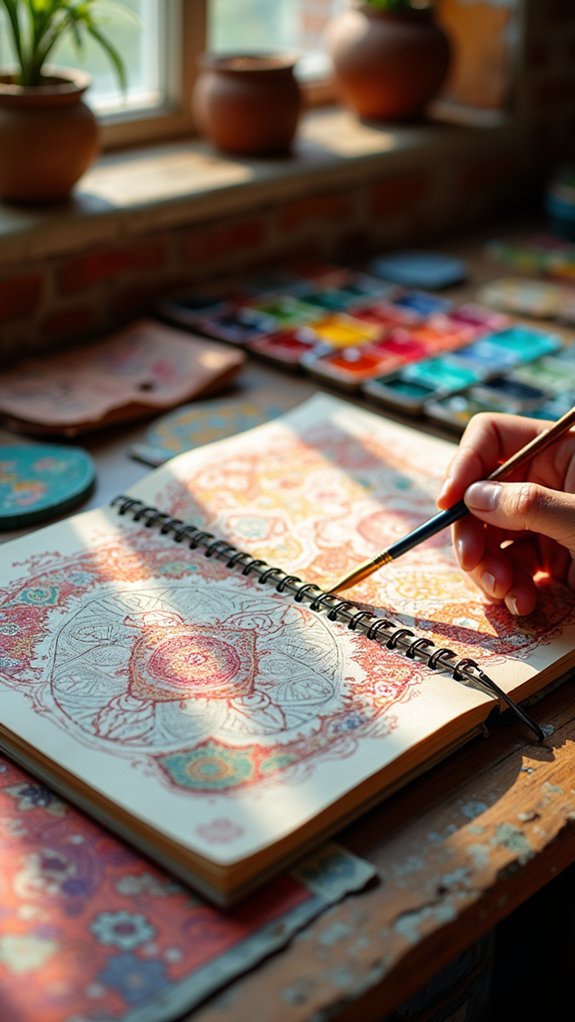
Patterns are everywhere—on grandma’s curtains, in the sidewalk tiles, even swirling in a bowl of cereal if you look hard enough.
Jumping into Pattern Exploration can turn any boring sketchbook page into a playground of Repetitive Design. When artists repeat shapes, lines, or doodles, they create a Visual Rhythm that makes any artwork groove, almost like it’s quietly dancing on its own.
It’s relaxing, too—sketching simple patterns or zentangles can feel like a brain massage after a stressful school day.
Take a look around; there are endless patterns to play with!
- Bright zigzags inspired by woven baskets
- Spiraling circles found in snail shells
- Checkerboard designs from chess boards
- Wavy lines like ripples in a puddle
- Leafy motifs borrowed from garden hedges
Use Photographs for Inspiration
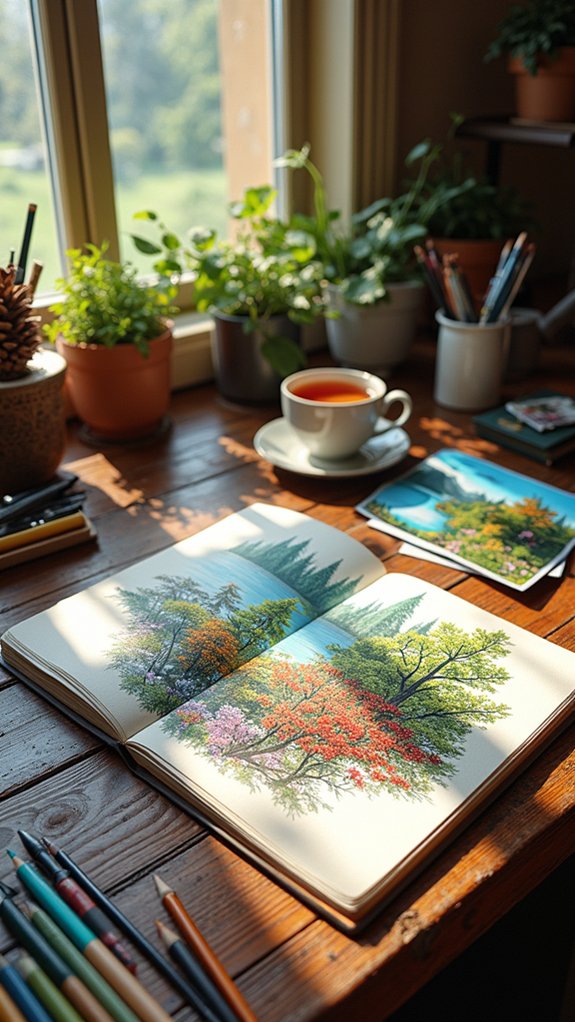
Photographs are like little treasure chests stuffed with inspiration, just waiting to be cracked open in a sketchbook session.
Whether someone snaps a picture of a wild city street, their pet’s latest nap pose, or an epic sunset, photos capture details that eyes might skip in real life. Using photographic composition helps artists frame their sketches with balance and drama, like a director picking the perfect camera angle.
Personal snapshots tell stories, too, letting artists plunge into emotional storytelling—sometimes a simple selfie brings back a whole summer’s worth of memories!
Photos also inspire bold choices: black-and-white images can lead to wild shading experiments, while colorful scenes might spark mixed media exploration, blending sketches with cut-out photos for an eye-catching twist.
Instant inspiration, no travel required!
Mix Different Media and Techniques
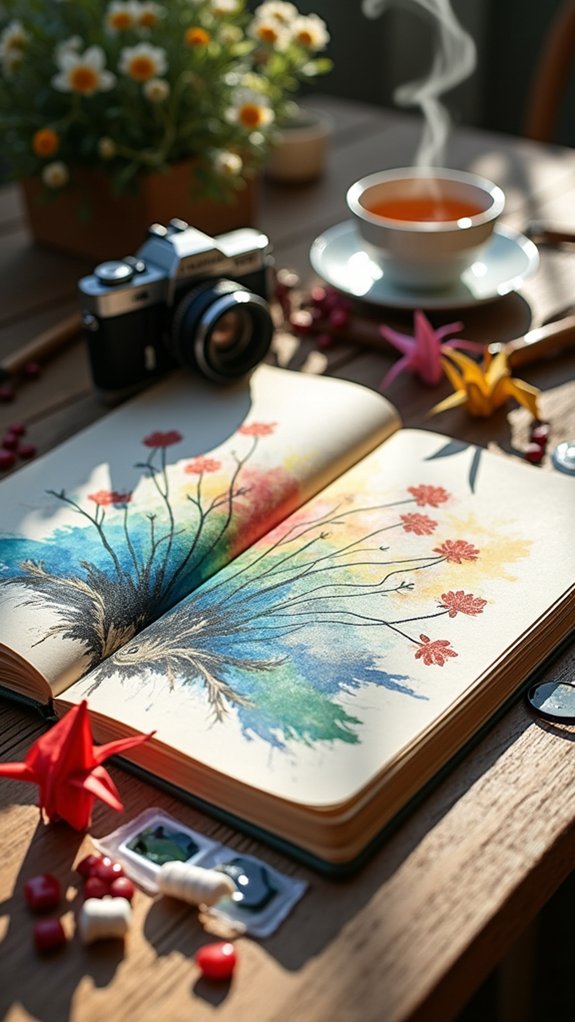
Sometimes a cool photo isn’t quite enough to capture all the wild ideas swirling around inside an artist’s head—that’s where mixing up different media steps in, ready to shake things up.
Trying out mixed media techniques is like being a mad scientist in your own art lab. Just imagine the wild, innovative contrasts you get when you mash watercolor with chunky gouache, or scribble charcoal over bold acrylic paint! Not only does this let you try out texture exploration, but adding bits like magazine clippings or buttons can really make your art pop—literally.
The best part? Every experimental mess becomes a fun story in your sketchbook.
- Layer graphite and ink for dramatic effects
- Splash watercolors beside thick gouache
- Collage found objects onto painted backgrounds
- Mix colored pencils with markers and paint
- Blend soft pastels over textured acrylics
Frequently Asked Questions
How to Make Sketchbook Pages More Interesting?
To make sketchbook pages more interesting, one might introduce colorful textures using unusual materials, such as fabric or textured paper. Combining mixed media like watercolor, ink, and collage encourages experimentation and adds dynamic, visually engaging elements to each page.
How Can I Make My GCSE Art Sketchbook Better?
Improving a GCSE art sketchbook involves focused art style exploration, consistent technique experimentation with materials like watercolor or colored pencils, and maintaining theme consistency, while reflective annotations and regular updates demonstrate both technical growth and creative thought progression.
What Should I Draw Next?
When considering what to draw next, one might explore creative prompts to spark originality, capture nature scenes for observational practice, or interpret abstract concepts to develop expressive skills, ensuring a diverse and enriching selection of sketchbook content.
How Do I Keep My Sketchbook Pages From Smudging?
To address smudge prevention techniques, one should select suitable paper types such as acid-free or heavyweight, carefully consider art medium choices, allow each layer to dry completely, use minimal pressure, and add interleaving sheets for extra protection.
Conclusion
With all these sketchbook ideas, there’s honestly no excuse for blank pages! Whether someone scribbles funky patterns, sketches those super-cool sculptures, or goes wild mixing media, inspiration is everywhere—sometimes even hiding under your nose (or your homework). So pick up that pencil, release the creativity monsters, and fill those pages with bold, messy, and amazing art. Remember, mistakes just make things interesting! Now, go make that sketchbook burst with personality. Who knows what’ll appear next?

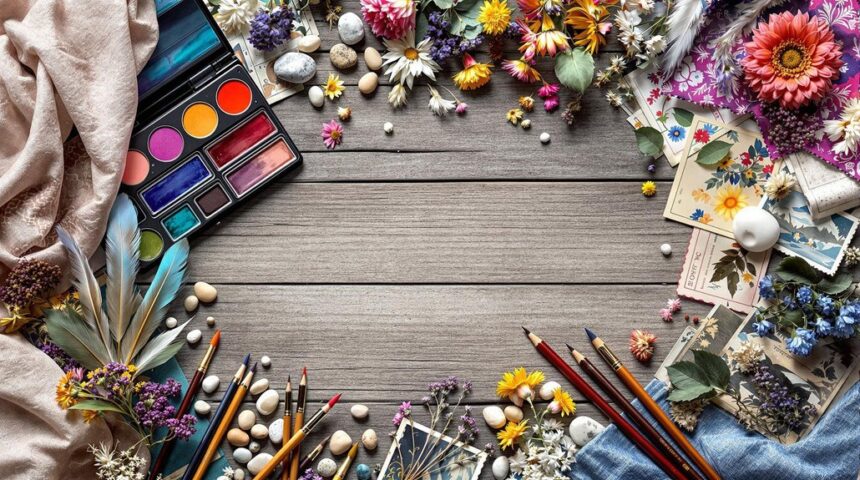
Leave a Reply